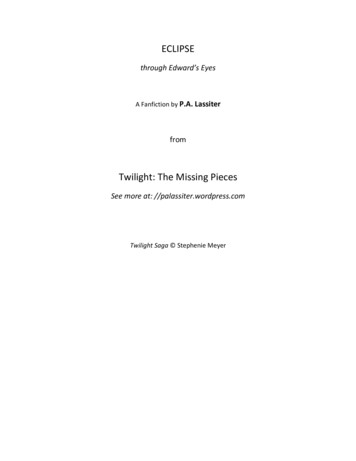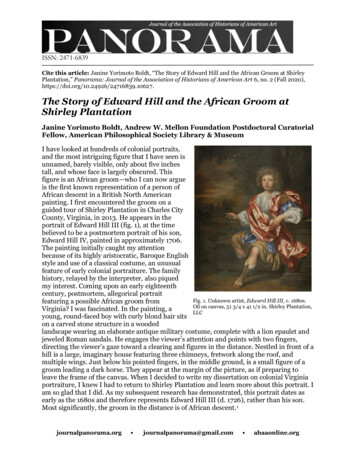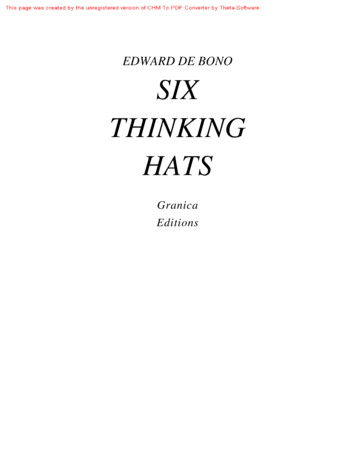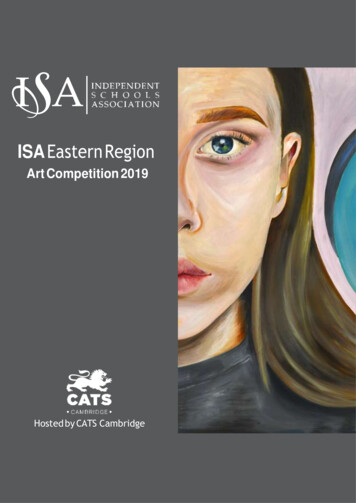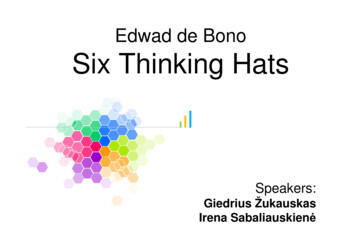
Transcription
Edward de Bono S I X T H I N K I N G H AT SRevised and Updated
ContentsPreface1 Introduction2 Six Hats, Six Colours3 Using the HatsThe White Hat4 The White Hat: Facts and Figures5 White Hat Thinking: Whose Fact Is It?6 White Hat Thinking: Japanese-Style Input7 White Hat Thinking: Facts, Truth and Philosophers8 White Hat Thinking: Who Puts on the Hat?9 Summary of White Hat ThinkingThe Red Hat10 The Red Hat: Emotions and Feelings11 Red Hat Thinking: The Place of Emotions in Thinking12 Red Hat Thinking: Intuition and Hunches13 Red Hat Thinking: Moment to Moment14 Red Hat Thinking: The Use of Emotions15 Red Hat Thinking: The Language of Emotions16 Summary of Red Hat ThinkingThe Black Hat17 The Black Hat: Cautious and Careful18 Black Hat Thinking: Content and Process19 Black Hat Thinking: The Past and the Future20 Black Hat Thinking: The Problem of Overuse21 Summary of Black Hat ThinkingThe Yellow Hat22 The Yellow Hat: Speculative-Positive23 Yellow Hat Thinking: The Positive Spectrum24 Yellow Hat Thinking: Reasons and Logical Support25 Yellow Hat Thinking: Constructive Thinking
26 Yellow Hat Thinking: Speculation27 Yellow Hat Thinking: Relation to Creativity28 Summary of Yellow Hat ThinkingThe Green Hat29 The Green Hat: Creative Thinking30 Green Hat Thinking: Lateral Thinking31 Green Hat Thinking: Movement Instead of Judgement32 Green Hat Thinking: The Need for Provocation33 Green Hat Thinking: Alternatives34 Green Hat Thinking: Personality and Skill35 Green Hat Thinking: What Happens to the Ideas?36 Summary of Green Hat ThinkingThe Blue Hat37 The Blue Hat: Control of Thinking38 Blue Hat Thinking: Focus39 Blue Hat Thinking: Program Design40 Blue Hat Thinking: Summaries and Conclusions41 Blue Hat Thinking: Control and Monitoring42 Summary of Blue Hat Thinking43 Benefits of the Six Hats MethodConclusionFollow Penguin
PENGUIN LIFESIX THINKING HATSEdward de Bono invented the concept of lateral thinking. A world-renownedwriter and philosopher, he is the leading authority in the field of creativethinking and the direct teaching of thinking as a skill. In the decades since Drde Bono introduced lateral thinking, the concept has become so entrenched inour language that it is used equally in physics lectures, television comedies orbrainstorming sessions. His key contribution has been his understanding ofthe brain as self-organising system. His work spans generations, continentsand belief systems, and is equally influential in the boardrooms of leadingbusinesses such as Apple and British Airways as on the shelves of classroomsin rural Africa.Dr de Bono has written more than sixty books, in forty languages, with peoplenow teaching his methods worldwide. He has chaired a special summit ofNobel Prize laureates, had faculty appointments at the universities of Oxford,London, Cambridge and Harvard, and been hailed as one of the 250 peoplewho have contributed most to mankind.Dr de Bono’s classic bestsellers include Six Thinking Hats, Lateral Thinking, IAm Right You Are Wrong, How To Be More Interesting, Teach Yourself ToThink, Teach Your Child How To Think, and Simplicity.www.debono.com
PrefaceThe Six Thinking Hats method may well be the most important change inhuman thinking for the past twenty-three hundred years.That may seem a rather exaggerated claim but the evidence is beginning topoint that way. When this book was first published fourteen years ago, such aclaim would have been nonsense. But over the years, the evidence to supportit has been steadily accumulating.A major corporation (ABB) used to spend thirty days on their multinationalproject team discussions. Using the parallel thinking of the Six Hats method,the discussions now take as little as two days. A researcher from a top IBMlaboratory told me that the Six Hats method had reduced meeting times to onequarter of what they had been. Statoil in Norway had a problem with an oilrig that was costing about one hundred thousand dollars a day. A certifiedtrainer, Jens Arup, introduced the Six Hats method and in twelve minutes theproblem was solved – and the one-hundred-thousand-dollar-a-day expenditurewas reduced to nil. There were two similar law cases: in one case the jurytook more than three hours to reach a decision. In the second case, one jurorintroduced the Six Hats method. A decision was reached in fifteen minutes. Ina simple experiment with three hundred senior civil servants, the introductionof the Six Hats method increased thinking productivity by 493 per cent.Those examples show huge changes. We are normally very happy withproductivity increases of 5 or 10 per cent. Here we have changes of 500 percent and more. Something is happening.Widespread Use Around the WorldI can report that the Six Hats method is now very widely used around theworld. When I first designed the concept I had no idea how rapid the spreadwould be. The method is simple, robust and effective – which accounts for thevery widespread use.Last year I received two letters on the same day. One letter was from thehead of research at Siemens in Germany. Siemens is by far the largestcorporation in Europe with close to four hundred thousand employees and a
turnover in excess of sixty billion dollars. They now have thirty-seveninternal trainers in my methods and every department has a special‘innovation unit’ based on my methods. In his letter, the head of research toldhow he had used the Six Hats method with success at a senior researchmeeting. The second letter was from Simon Batchelor, who had been on anaid mission to Cambodia to help the Khmer villagers drill for water. He foundit difficult to get the villagers involved in the process. He had my book TeachYour Child How To Think with him and, from this book, he taught the SixHats method to the Khmer villagers. They became so enthusiastic that theytold him that learning to think was more important than drilling for water.A few days later I was in Wellington, New Zealand, and the head teacher ofWellesley School (a leading school in New Zealand) told me that he wasteaching the method to five-year-olds. (A few months later, the head teacherof Clayfield College in Brisbane told me that they even taught it to four-yearolds.) A week after being in New Zealand I spoke at a major Microsoftmarketing meeting in Seattle and introduced the attendees to the parallelthinking of the Six Hats method. The method has been used by NASA, IBM,DuPont, NTT (Japan), Shell, BP, Statoil (Norway), Marzotto (Italy), andFederal Express, among many others. This shows the remarkable adaptabilityof the Six Hats method: it can be taught with equal success to top-levelexecutives and to pre-school children.The Six Hats MethodThinking is the ultimate human resource. Yet we can never be satisfied withour most important skill. No matter how good we become, we should alwayswant to be better. Usually, the only people who are very satisfied with theirthinking skill are those poor thinkers who believe that the purpose of thinkingis to prove yourself right – to your own satisfaction. If we have only a limitedview of what thinking can do, we may be smug about our excellence in thisarea, but not otherwise.The main difficulty of thinking is confusion. We try to do too much at once.Emotions, information, logic, hope and creativity all crowd in on us. It is likejuggling with too many balls.What I am putting forward in this book is a very simple concept whichallows a thinker to do one thing at a time. He or she becomes able to separateemotion from logic, creativity from information, and so on. The concept isthat of the six thinking hats. Putting on any one of these hats defines a certaintype of thinking. In the book I describe the nature and contribution of eachtype of thinking.
The six thinking hats allow us to conduct our thinking as a conductor mightlead an orchestra. We can call forth what we will. Similarly, in any meeting itis very useful to switch people out of their usual track in order to get them tothink differently about the matter in hand.It is the sheer convenience of the six thinking hats that is the main value ofthe concept.Special Note on the Black HatI am writing this special note because a few people have misinterpreted theblack hat and have somehow regarded it as a bad hat. On the contrary, theblack hat is the most valuable of all the hats and certainly the most used.Using the black hat means being careful and cautious. The black hat pointsout difficulties, dangers and potential problems. With the black hat you avoiddanger to yourself, to others and to the community. It is under the black hatthat you point out possible dangers.For the most part, the thrust of Western thinking has been the ‘black hat’with an emphasis on critical thinking and caution. It prevents mistakes,excesses and nonsenses.Notes on the New EditionToday, there is a huge amount of experience using the Six Hats method. Thiswas not the case when I first wrote the book. The method can therefore beintroduced with confidence. It is no longer a matter of trying out somethingnew and exotic. It is now a matter of catching up with a powerful thinkingmethod that has been in use for fourteen years across all ages, cultures andabilities.People are sometimes hesitant about the hats and colours because they donot seem serious or complicated enough (some people love complexity). Inpractice, the simplicity has never been a problem. People realize they need thehats and colours as simple mental hooks. Hats and colours are much easier toremember than are complicated psychological terms.This revised and updated edition is based on my experience using andworking with the Six Hats method. Over the years it has become apparent thatthe method is both powerful and easy to use. The effectiveness of the methodis much greater than I had ever imagined. It is an alternative to the argumentsystem, which was never intended to be constructive or creative. With the SixHats method the emphasis is on ‘what can be’ rather than just on ‘what is’,and on how we design a way forward – not on who is right and who is wrong.
Chapter 1IntroductionAn antelope grazing in Africa hears a sound in the grass. Immediately all theneuronal clusters concerned with danger are activated so that the lion isrecognized as soon as it emerges from the grass, and the antelope is able toescape. Such sensitization is a key part of how the brain works and why it isso efficient.It is not possible to be sensitized in different directions at the same time justas it would not be possible to design a golf club that was the best club fordriving and at the same time the best club for putting. That is why the SixHats method is essential. It allows the brain to maximize its sensitivity indifferent directions at different times. It is simply not possible to have thatmaximum sensitization in different directions all at the same time.Argument versus Parallel ThinkingThe basic idea behind Western thinking was designed about twenty-threehundred years ago by the Greek ‘Gang of Three’ and is based on argument.Socrates put great emphasis on dialectic and argument. In 80 per cent of thedialogues in which he was involved (as written down by Plato) there is noconstructive outcome at all. Socrates saw his role as simply pointing out whatwas ‘wrong’. He wanted to clarify the correct use of concepts like justice andlove by pointing out incorrect usage. Plato believed that the ‘ultimate’ truthwas hidden below appearances. His famous analogy is of a person chained upin a cave so that he can see only the back wall of the cave. There is a fire atthe entrance to the cave. After a person enters the cave, his shadow isprojected on to the back wall of the cave and that is all the chained-up personcan see. Plato used this analogy to point out that as we go through life we cansee only the ‘shadows’ of the truth.Aristotle systematized inclusion/exclusion logic. From past experience wewould put together ‘boxes’, definitions, categories or principles. When wecame across something, we judged into which box it fell. Something could be
in the box or not in the box. It could not be half in and half out – nor could itbe anywhere else.As a result, Western thinking is concerned with ‘what is’, which isdetermined by analysis, judgement and argument.That is a fine and useful system. But there is another whole aspect ofthinking that is concerned with ‘what can be’, which involves constructivethinking, creative thinking and ‘designing a way forward’.In 1998, I was asked to give an opening talk at the AustralianConstitutional Convention that was looking at the future of federation. I toldthe following story.Once upon a time a man painted half his car white and the other half black.His friends asked him why he did such a strange thing. He replied: ‘Because itis such fun, whenever I have an accident, to hear the witnesses in courtcontradict each other.’At the end of the convention the chairperson, Sir Anthony Mason, told methat he was going to use that story because it is so often the case in anargument that both sides are right but are looking at different aspects of thesituation.Many cultures in the world, perhaps even the majority of cultures, regardargument as aggressive, personal and non-constructive. That is why so manycultures readily take up the parallel thinking of the Six Hats method.A Changing WorldA thinking system based on argument is excellent just as the front left wheelof a car is excellent. There is nothing wrong with it at all. But it is notsufficient.A doctor is treating a child with a rash. The doctor immediately thinks ofsome possible ‘boxes’. Is it sunburn? Is it food allergy? Is it measles? Thedoctor then examines the signs and symptoms and makes a judgement. If thedoctor judges that the condition fits into the ‘measles’ box, then the treatmentof measles is written on the side of that ‘box’ and the doctor knows exactlywhat to do. That is traditional thinking at its best.From the past we create standard situations. We judge into which ‘standardsituation box’ a new situation falls. Once we have made this judgement, ourcourse of action is clear.Such a system works very well in a stable world. In a stable world thestandard situations of the past still apply. But in a changing world the standard
situations may no longer apply.Instead of judging our way forward, we need to design our way forward.We need to be thinking about ‘what can be’, not just about ‘what is’.Yet the basic tradition of Western thinking (or any other thinking) has notprovided a simple model of constructive thinking. That is precisely what theSix Hats method (parallel thinking) is all about.What Is Parallel Thinking?There is a large and beautiful country house. One person is standing in frontof the house. One person is standing behind the house. Two other people arestanding at each side of the house. All four have a different view of the house.All four are arguing (by intercom) that the view each is seeing is the correctview of the house.Using parallel thinking they all walk around and look at the front. Thenthey all walk around to the side, then the back and finally the remaining side.So at each moment each person is looking in parallel from the same point ofview.This is almost the exact opposite of argument, adversarial, confrontationalthinking where each party deliberately takes an opposite view. Because eachperson eventually looks at all sides of the building, the subject is exploredfully. Parallel thinking means that at any moment everyone is looking in thesame direction.But parallel thinking goes even further. In traditional thinking, if twopeople disagree, there is an argument in which each tries to prove the otherparty wrong. In parallel thinking, both views, no matter how contradictory,are put down in parallel. If, later on, it is essential to choose between thedifferent positions, then an attempt to choose is made at that point. If a choicecannot be made, then the design has to cover both possibilities.At all times the emphasis is on designing a way forward.Directions and HatsThe essence of parallel thinking is that at any moment everyone is looking inthe same direction – but the direction can be changed. An explorer might beasked to look north or to look east. Those are standard direction labels. So weneed some direction labels for thinking. What are the different directions inwhich thinkers can be invited to look?This is where the hats come in.
In many cultures there is already a strong association between thinking and‘thinking hats’ or ‘thinking caps’. The value of a hat as a symbol is that itindicates a role. People are said to be wearing a certain hat. Anotheradvantage is that a hat can be put on or taken off with ease. A hat is alsovisible to everyone around. For those reasons I chose hats as the symbols forthe directions of thinking.Although physical hats are sometimes used, the hats are usually imaginary.Posters of the hats on the walls of meeting rooms often are used, however, asa reminder of the directions. There are six coloured hats corresponding to thesix directions of thinking: white, red, black, yellow, green, blue.Directions Not DescriptionsIt is very important to note that the hats are directions and not descriptions ofwhat has happened. It is not a matter of everyone saying what they like andthen the hats being used to describe what has been said. It is a matter ofsetting out to think in that direction.‘Let’s have some white hat thinking here’ means a deliberate focus oninformation. Everyone now tries to think of information that is available,information that is needed, questions to be asked, other ways of gettinginformation, and so on.‘I want your red hat on this’ is a specific request for feelings, intuition andemotions on a particular issue.‘That is good black hat thinking; now let us switch to some yellow hatthinking ’ In this case the term black hat describes thinking that seems to becautious and seems to point out possible difficulties, but the main intention isto ask for a switch to the yellow hat direction (benefits, values, and so forth).It is extremely important to appreciate the difference between descriptionand direction. A description is concerned with what has happened. A directionis concerned with what is about to happen.‘I want you to look to the east’ is very different from ‘You have beenlooking to the east.’‘I want you to cook some scrambled eggs’ is very different from ‘I see thatyou have cooked some scrambled eggs.’Not Categories of PeopleIt is possible to create tests to determine whether a person is type A or type B,or any similar descriptive discriminations. Psychologists do that all the time.
The difficulty is that once people have been put into ‘boxes’ they tend to staythere. Again, that is an example of ‘what is’ instead of ‘what can be’.In a race a thin man would usually beat a fat man (‘what is’). But if the fatman learns to ride a bicycle, then the fat man will beat the thin man (‘whatcan be’).There is a huge temptation to use the hats to describe and categorizepeople, such as ‘she is black hat’ or ‘he is a green-hat person’. Thattemptation must be resisted. The hats are not descriptions of people but modesof behaviour.It is true that some people may be permanently cautious and inclined tolook for dangers. It is true that some people might always be bubbling withideas and others might be better at focusing on facts. People may prefer onemode to another. People might be better at one mode than another.Nevertheless, the hats are not categories of people.If you drive a car with manual gears, you use all the gears. In the engine ofyour car all the cylinders are firing. The hats are directions of thinking. Everyperson must be able, and skilled, to look in all the directions.For those reasons the use of the hats as labels is dangerous because itdestroys the whole point of the system, which is that everyone can look inevery direction.Note on Using the Thinking HatsWhen people tell me that they have been using the Six Hats method, I oftenask how they have been using it, and discover that sometimes they have beenusing it incorrectly. In a meeting, someone has been chosen as the black hatthinker, someone else as the white hat thinker, and so on. The people thenkeep those roles for the whole meeting. That is almost exactly the opposite ofhow the system should be used. The whole point of parallel thinking is thatthe experience and intelligence of everyone should be used in each direction.So everyone present wears the black hat at the appointed time. Everyonepresent wears the white hat at another time. That is parallel thinking andmakes fullest use of everyone’s intelligence and experience.Showing OffMany people tell me that they enjoy argument because they can show off howclever they are. They can win arguments and demolish opponents. None ofthat is very constructive but there may be a human need to show off.
Thus showing off is not excluded from parallel thinking and the Six Hatsmethod. A thinker now shows off by showing how many considerations he orshe can put forward under the yellow hat, how many under the black hat, andso forth. You show off by performing well as a thinker. You show off byperforming better as a thinker than others in the meeting. The difference isthat this type of showing off is constructive. The ego is no longer tied to beingright.Playing the GameThere are all sorts of attempts made to change the personalities of people. It isbelieved that if you point out a personality type or a weakness, the person willseek to compensate for that weakness. Such methods are generally slow,ineffective and do not work.Once people are put into a certain ‘box’ or category they may try tocompensate. But the effort of compensation reminds them of ‘what they are’,so they sink even deeper into that category.Ever since Freud, the emphasis has been on analysis: find out the deeptruths and motivations for action. Confucius’s approach was almost the exactopposite. Instead of focusing on personality he chose to focus directly onbehaviour. He urged you to use the right behaviour with your colleagues, yoursubordinates, your superiors and your family. Confucius was not the least bitinterested in your personality or psychological make-up.The Six Hats method follows the Confucian approach rather than theanalytical one. The rules of behaviour are laid out. You follow those rules. Ifyou are aggressive, no one is going to try to make you less aggressive. But ifthe yellow hat is in use, then you are to use your aggression in that direction.By going straight to behaviour, the Six Hats method is much moreacceptable and effective and quick than methods that set out to changepersonalities.The ‘game’ aspect of the Six Hats is very important. If a game is beingplayed, then anyone who does not obey the rules of the game is considereduncooperative. If there is a switch from the black hat (caution) to the yellowhat (possible benefits) and a person continues to lay out the potential dangers,then that person is seen to be refusing to play the game. Getting people to‘play the game’ is a very powerful form of changing behaviour.Results
Over the years the results of using the Six Hats method have becomeincreasingly clear. The results are based on feedback from many sources andfall into four broad categories that are summarized here.PowerWith the Six Hats method, the intelligence, experience and knowledge of allthe members of the group are fully used. Everyone is looking and working inthe same direction.A magnet is powerful because all the particles are aligned in the samedirection. That is not the case with argument or free discussion. With theargument mode (as in a court of law), each party seeks to win the case. If oneparty thinks of a point that might benefit the other party, then that point isnever raised. The purpose is to win, not to explore the subject honestly.It is totally absurd that a person should hold back information or a point ofview because revealing it would weaken his or her argument. The focusing ofthe sun’s rays can melt the toughest of metals. In the same way, the focusingof the mental ability of many people on a problem can more easily solve thatproblem.Time SavingOptus (in Australia) had set aside four hours for an important discussion.Using the Six Hats method the discussion was concluded in forty-fiveminutes.From every side there are reports of how much quicker meetings becomewhen the six hats are used. Meetings take half the time. Meetings take a thirdor a quarter of the time. Sometimes, as in the case of ABB, meetings takeone-fifteenth of the time.In the United States, managers spend nearly 40 per cent of their time inmeetings. If the Six Hats method reduced all meeting times by 75 per cent,you would have created 30 per cent more manager time – at no extra costwhatsoever.In normal thinking or argument, if someone says something, then othershave to respond – even if only out of politeness. But that is not the case withparallel thinking.With parallel thinking, every thinker at every moment is looking in thesame direction. The thoughts are laid out in parallel. You do not respond to
what the last person has said. You simply add another idea in parallel. In theend, the subject is fully explored quickly.Normally, if two points of view are at odds, then they are argued out. Withparallel thinking, both points of view are laid out alongside each other. Lateron, if it is essential to decide between the two, a decision is made. So there isnot argument at every step.Removal of EgoPerhaps the biggest obstacle to quick and effective thinking is the ego. Peopletend to use thinking to parade their egos. Thinking is used to attack and putdown other people. Thinking is used to get your own way. Thinking is used toshow others how clever you are. Thinking is used to express personalantagonisms.Someone will choose to disagree on a point simply to show up the personwho has made that point. If another person had made the point, there wouldhave been full agreement. In general, we do not fully realize just howobstructive the ego is in preventing effective thinking.During jury deliberations, there are often two personalities who refuse toagree whatever the evidence might be. Judges have told me that there is amuch more serious problem than most people realize. Clearly, the problemdestroys the basic value of the jury system. That is why there is now interestin several countries in training all juries in the Six Hats method. This wouldspeed up deliberations by removing the ego problem.Confrontational and adversarial thinking exacerbate the ego problem. SixHats thinking removes it. With the Six Hats method you exert your ego byperforming well as a thinker under each of the hats.The Six Hats method provides neutral and objective exploration of asubject – argument does not.One Thing at a TimeConfusion is the biggest enemy of good thinking. We try to do too manythings at the same time. We look for information. We are affected by feelings.We seek new ideas and options. We have to be cautious. We want to findbenefits. Those are a lot of things that need doing.Juggling with six balls at the same time is rather difficult. Tossing up oneball at a time is much easier.
With the Six Hats method, we try to do only one thing at a time. There is atime when we look for danger (black hat). There is a time when we seek newideas (green hat). There is a time when we focus on information (white hat).We do not try to do everything at the same time.With colour printing, each colour is printed separately, one at a time, and inthe end the full colour effect is obtained. It is the same with Six Hat thinking– we do one thing at a time and in the end the full picture emerges.Underneath all this is the absolute physiological need to separate out thetypes of thinking. As I mentioned in the introduction, the brain is sensitized tolook for danger and sensitized to seek benefits through a different chemicalsetting.Aeroplanes coming in to land often fly over car parks. If you tell yourselfto notice the yellow cars, then suddenly the yellow cars stand out and makethemselves visible. That is an example of sensitization.You cannot be sensitized in different directions at the same time, so whenwe set out to do all aspects of thinking in the same moment, we are going tobe suboptimal on all of them.All the points mentioned in this section may seem obvious and logical. In fact, there is no mysteryabout them. When the Six Hats method is used, the advantages soon become clear. Instead oframbling, ego-driven meetings, meetings are now constructive, productive and much faster.People do not choose argument because it is the preferred method. Theysimply do not know any other way. The Six Hats provides another way.
Chapter 2Six Hats, Six ColoursEach of the six thinking hats has a colour: white, red, black, yellow, green,blue. The colour provides the name for the hat.I could have chosen clever Greek names to indicate the type of thinkingrequired by each hat. That would have been impressive and would havepleased some people. But it would be of little practical value since the nameswould be difficult to remember.I want thinkers to visualize and to imagine the hats as actual hats. For thisto happen colour is important. How else could you distinguish between thehats? Different shapes would again be difficult to learn and would beconfusing. Colour makes the imaging easier.The colour of each hat is also related to its function.White Hat White is neutral and objective. The white hat is concerned withobjective facts and figures.Red Hat Red suggests anger (seeing red), rage and emotions. The red hatgives the emotional view.Black Hat Black is sombre and serious. The black hat is cautious andcareful. It points out the weaknesses in an idea.Yellow Hat Yellow is sunny and positive. The yellow hat is optimistic
The Six Thinking Hats method may well be the most important change in human thinking for the past twenty-three hundred years. That may seem a rather exaggerated claim but the evidence is beginning to point that way. When this book was first published fourteen years ago, such a claim would have been nonsense. But over the years, the evidence to .

